11.04.2025
Soil and rocks returned from the moon's far side suggest it may be drier than the side constantly facing Earth

CAPE CANAVERAL, Fla. -- Soil and rocks returned from the moon’s mysterious far side suggest it may be drier than the side constantly facing Earth, Chinese scientists reported Wednesday.
But they cautioned more samples are needed for a clearer picture.
A better understanding of the abundance of water in the lunar mantle can help explain how the moon evolved, the researchers noted. But it could also be all the more reason for astronauts to stick close to the near side of the moon as currently planned.
China became the first country to land on the moon’s far side last year. The Chang’e 6 spacecraft scooped up the volcanic rock and dirt from the ancient, sprawling South Pole-Aitken basin, one of the largest impact craters in the solar system.
The Chinese Academy of Sciences’ Sen Hu said he and his team received 5 grams of soil samples, then selected 578 particles for detailed analysis using electron microscopes.
They estimated the water abundance at less than 1.5 micrograms per gram, on the dry end of what’s been found in samples gathered over past decades from the moon’s near side. Measurements on samples from the near side have ranged between 1 microgram and 200 micrograms per gram.
Given the limited sampling, it’s uncertain how widespread this dry condition might be, the scientists noted in their study published in the journal Nature.
“More far side samples are required for testing and further unraveling" how much water there is, Hu said in an email.
It’s possible the impact that created this basin may have blasted water elements to the near side, leaving the far side depleted. Another possibility is that the vertical distribution of water could be different between the two hemispheres.
Even if confirmed, the findings shouldn’t drastically alter NASA’s plans to send astronauts to the moon’s south polar region, where permanently shadowed craters are believed to hold massive amounts of ice. This frozen water could be used for drinking, cooking and making rocket fuel.
NASA aims to send four astronauts around the moon next year under its Artemis program, the successor to Apollo, which put 12 men on the moon from 1969 through 1972. That would be followed by a landing near the lunar south pole by astronauts no earlier than 2027. China is seeking its own astronaut moon landing by 2030.
Quelle: abcNews
+++
China Focus: Drier lunar far side offers insight on moon's evolution
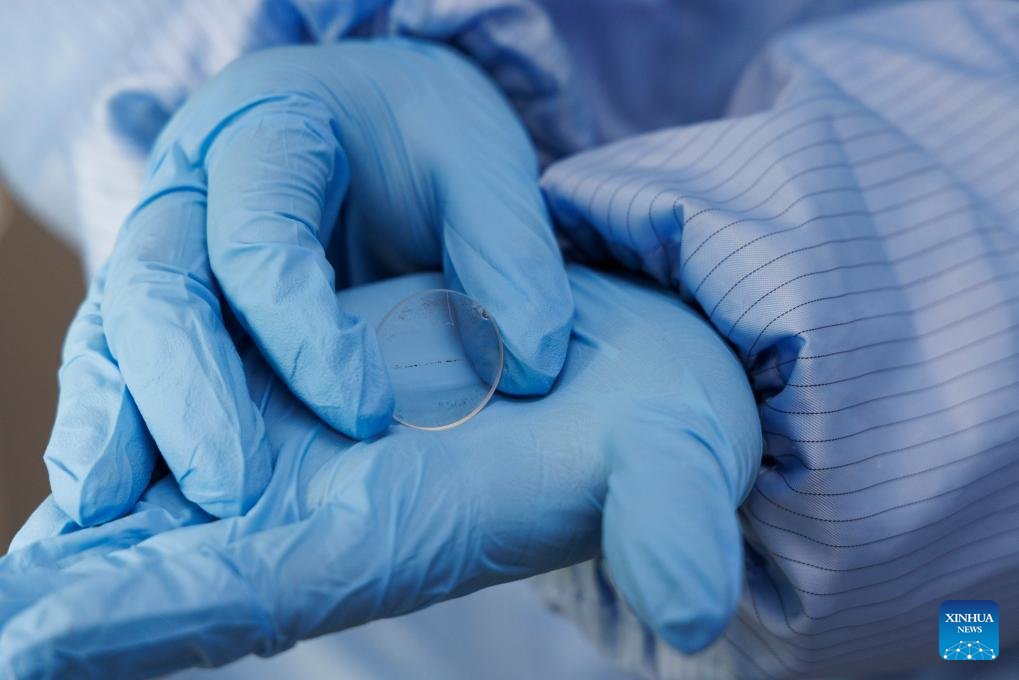
A researcher displays the lunar sample to be tested at the Nano Secondary Ion Mass Spectrometer Laboratory (NanoSIMS Lab) of the Institute of Geology and Geophysics of the Chinese Academy of Sciences in Beijing, capital of China, April 8, 2025. The latest discovery from rock samples returned by China's Chang'e-6 lunar mission reveals that the moon's mantle contains less water on the far side compared to the near side, suggesting that the "hidden hemisphere," which always faces away from Earth, tends to be much drier. Published in the journal Nature on Wednesday, a new study by Chinese scientists found that the water content in each gram of the thick rocky layer beneath the moon's far side surface is less than 2 micrograms, the lowest record ever reported. (Xinhua/Jin Liwang)
The latest discovery from rock samples returned by China's Chang'e-6 lunar mission reveals that the moon's mantle contains less water on the far side compared to the near side, suggesting that the "hidden hemisphere," which always faces away from Earth, tends to be much drier.
Published in the journal Nature on Wednesday, a new study by Chinese scientists found that the water content in each gram of the thick rocky layer beneath the moon's far side surface is less than 2 micrograms, the lowest record ever reported.
Previous studies on samples from the lunar near side have shown that the water concentrations within the moon's interior could reach up to 200 micrograms per gram.
"Such concentration in the new study can be measured between 1 and 1.5 parts per million," said lead researcher Hu Sen, a professor from the Institute of Geology and Geophysics of the Chinese Academy of Sciences.
"Even the driest desert on Earth contains around 2,000 parts per million of water - over a thousand times more than what's found on the lunar far side surface," Hu explained.
The global scientific community widely believes that the moon was formed when a Mars-sized object collided with Earth 4.5 billion years ago. During this extremely hot impact event, the moon was thought to be depleted of water and other volatile elements.
Over the past two decades, there has been debate about whether the water content in the moon's mantle, the middle layer between its surface and its core, is abundant or scarce, and all the published estimates were derived from the near side samples of the moon.
The Chang'e-6 lunar probe launched in early May 2024, landed in the moon's South Pole-Aitken Basin and returned to Earth in late June with more than 1,935 grams of the first-ever samples from the less-known far side of the moon.
According to Hu, the moon samples used in this study weigh 5 grams, consisting of 578 particles ranging in size from 0.1 to 1.5 millimeters. These particles were carefully sieved and hand-selected, 28 percent of which were mare basalt fragments.
"These samples provide an opportunity to investigate the water abundance of the far side lunar mantle and to unravel potential differences between the moon's two sides," Hu said.
People on Earth can only ever see one lunar face because the moon takes about the same amount of time to rotate once as it does to complete a single orbit of Earth. As a result, scientists divide the moon into two hemispheres, namely the side that always faces us, known as the near side, and the one that is always turned away from us, which we refer to as the far side of the moon.
The moon's far side has long been considered quite different from its near side. The latest example is a study published in Nature in November 2024 by Hu's colleagues, based on lunar samples collected at the Chang'e-6 landing site. The study revealed that a unique volcanic event dating back 2.8 billion years had not been observed in previous samples obtained from the near side of the moon.
Other differences also appeared in geological structures, landscapes, chemical composition and crustal thickness.
For Hu and his team, the newly found disparity in the moon's internal water content is of great significance, which may offer a fresh insight into the moon's formation and evolution.
"The water content in the lunar rocks plays a crucial role in testing the hypothesis of the moon's origin," Hu said. "If the water concentration reaches as much as 200 parts in the moon's rocky layer, it could challenge the existing hypothesis of the impact origin, and scientists need to propose a new model to explore the starting point of the moon's formation."
The results of the new study shows that the lunar water content remains below this 200 parts threshold, thereby supporting the existing impact formation theory, Hu noted.
Francis McCubbin, the Astromaterials Curator at NASA's Johnson Space and a peer reviewer of the paper, called their work "a landmark study on the water abundance of the lunar far side."
China has plans to launch a number of new moon missions including building a permanent moon base and landing a taikonaut crew before 2030.
According to the scientists, the findings of this study also hold significant implications for future lunar exploration tasks, as water on the moon is key to long-term human settlement.
"Since the two faces of the moon feature distinct topographical characteristics, landing in areas with substantial terrain undulations may demand more advanced control technologies," Hu told Xinhua. ■
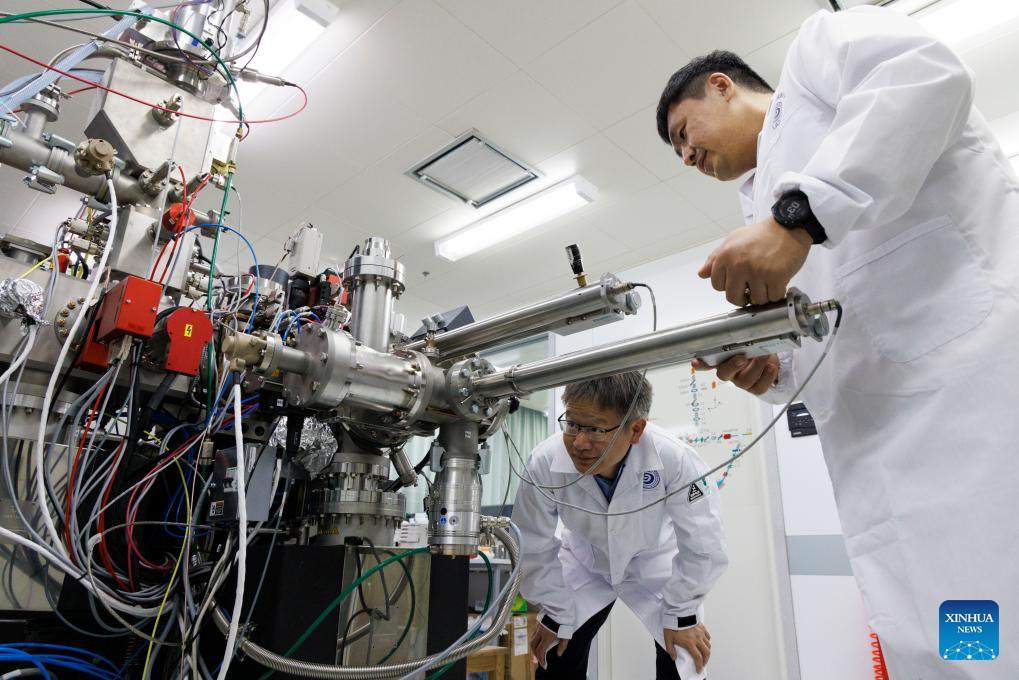
Lead researcher Hu Sen (L) deals with the lunar sample at the Nano Secondary Ion Mass Spectrometer Laboratory (NanoSIMS Lab) of the Institute of Geology and Geophysics of the Chinese Academy of Sciences in Beijing, capital of China, April 8, 2025.
The latest discovery from rock samples returned by China's Chang'e-6 lunar mission reveals that the moon's mantle contains less water on the far side compared to the near side, suggesting that the "hidden hemisphere," which always faces away from Earth, tends to be much drier.
Published in the journal Nature on Wednesday, a new study by Chinese scientists found that the water content in each gram of the thick rocky layer beneath the moon's far side surface is less than 2 micrograms, the lowest record ever reported. (Xinhua/Jin Liwang)
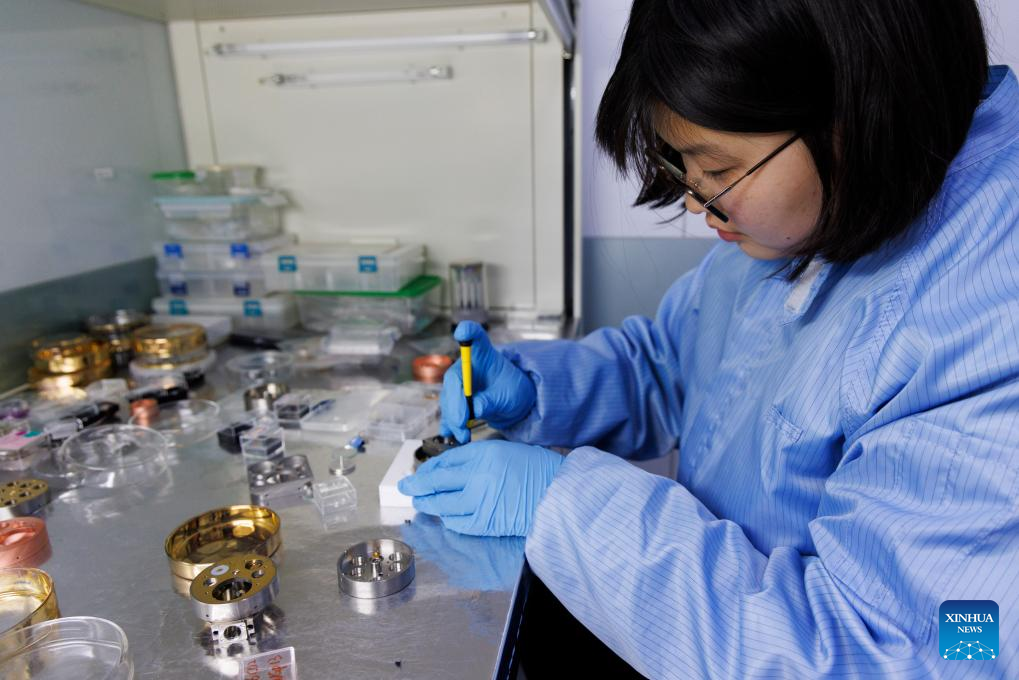
A researcher deals with the lunar sample to be tested at the Nano Secondary Ion Mass Spectrometer Laboratory (NanoSIMS Lab) of the Institute of Geology and Geophysics of the Chinese Academy of Sciences in Beijing, capital of China, April 8, 2025.
The latest discovery from rock samples returned by China's Chang'e-6 lunar mission reveals that the moon's mantle contains less water on the far side compared to the near side, suggesting that the "hidden hemisphere," which always faces away from Earth, tends to be much drier.
Published in the journal Nature on Wednesday, a new study by Chinese scientists found that the water content in each gram of the thick rocky layer beneath the moon's far side surface is less than 2 micrograms, the lowest record ever reported. (Xinhua/Jin Liwang)
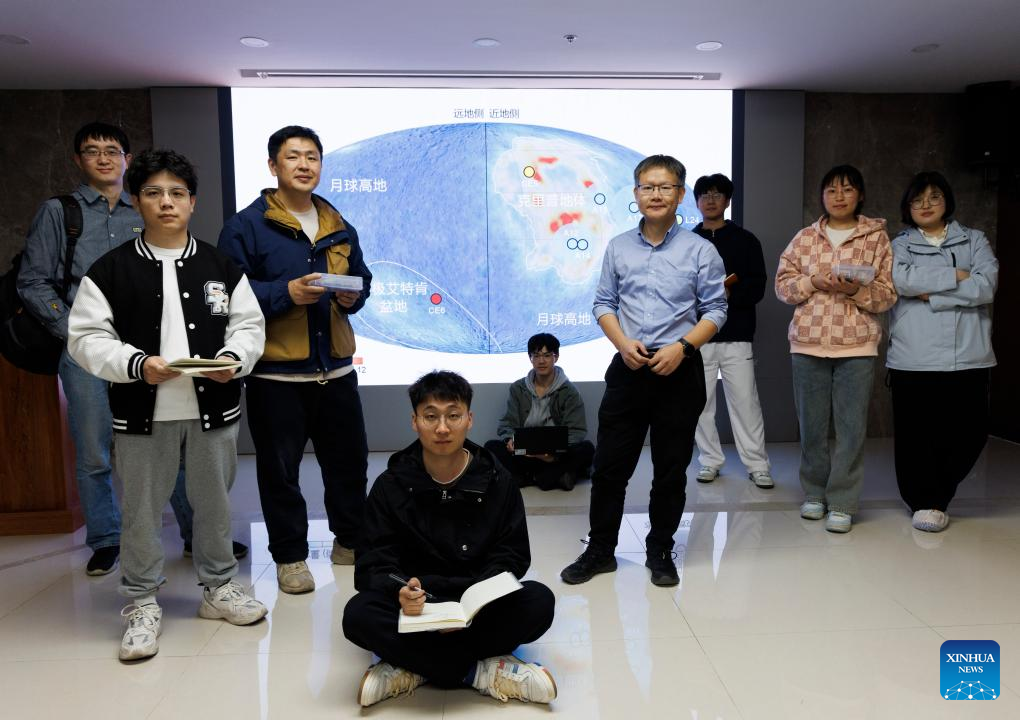
Lead researcher Hu Sen (4th R) poses for a group photo with the research team at the Institute of Geology and Geophysics of the Chinese Academy of Sciences in Beijing, capital of China, April 8, 2025.
The latest discovery from rock samples returned by China's Chang'e-6 lunar mission reveals that the moon's mantle contains less water on the far side compared to the near side, suggesting that the "hidden hemisphere," which always faces away from Earth, tends to be much drier.
Published in the journal Nature on Wednesday, a new study by Chinese scientists found that the water content in each gram of the thick rocky layer beneath the moon's far side surface is less than 2 micrograms, the lowest record ever reported. (Xinhua/Jin Liwang)
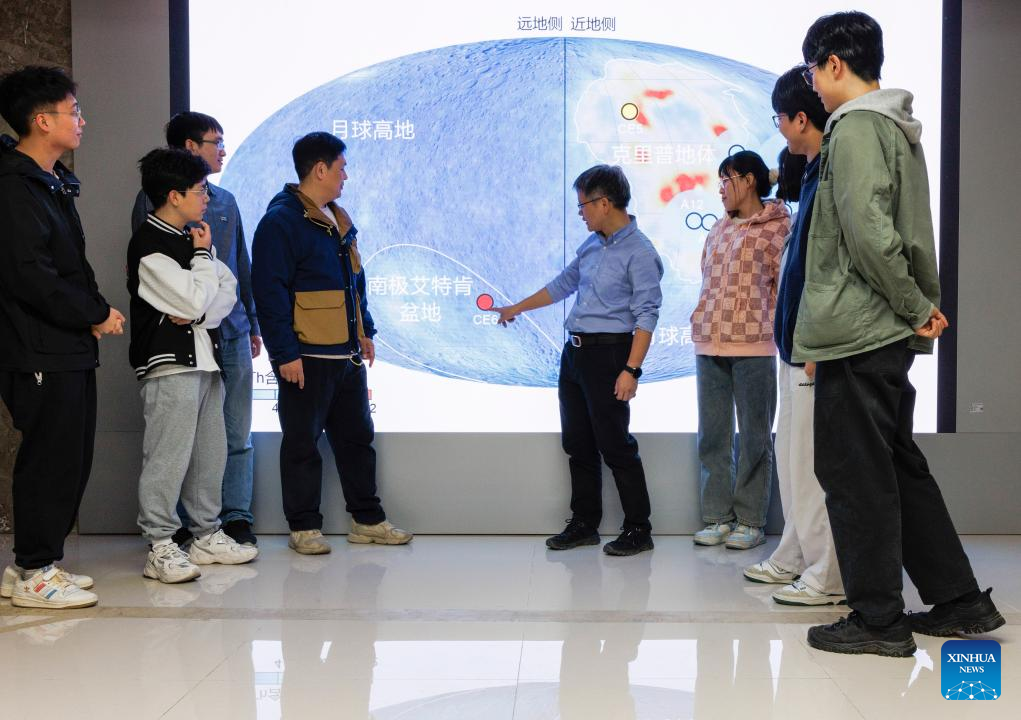
Lead researcher Hu Sen (5th L) explains the research result to the research team at the Institute of Geology and Geophysics of the Chinese Academy of Sciences in Beijing, capital of China, April 8, 2025.
The latest discovery from rock samples returned by China's Chang'e-6 lunar mission reveals that the moon's mantle contains less water on the far side compared to the near side, suggesting that the "hidden hemisphere," which always faces away from Earth, tends to be much drier.
Published in the journal Nature on Wednesday, a new study by Chinese scientists found that the water content in each gram of the thick rocky layer beneath the moon's far side surface is less than 2 micrograms, the lowest record ever reported. (Xinhua/Jin Liwang)
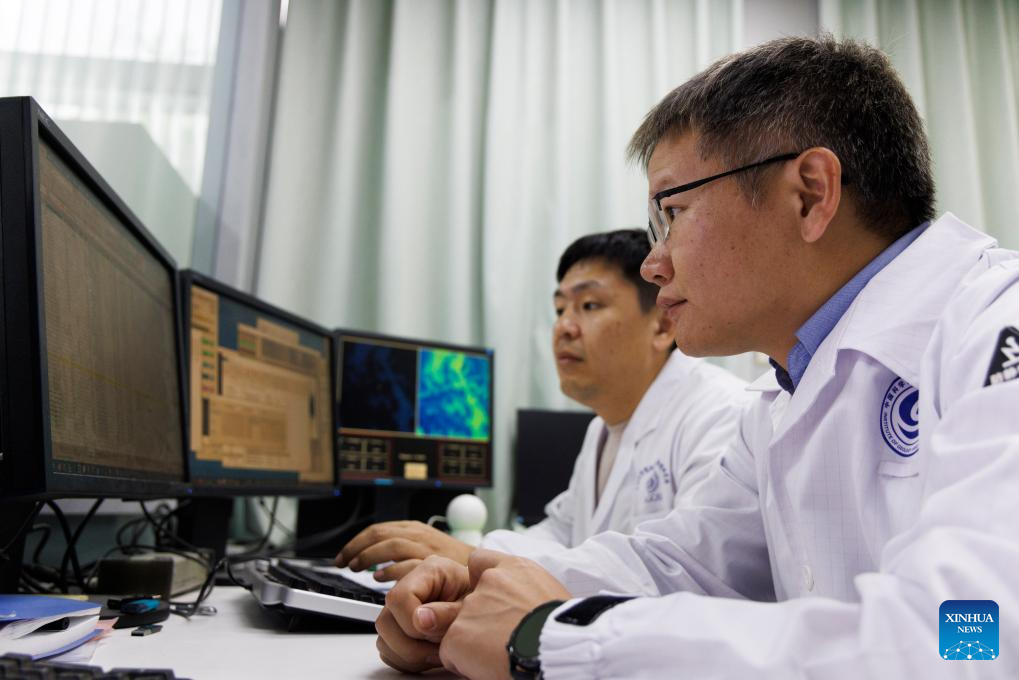
Lead researcher Hu Sen (front) observes the test data at the Nano Secondary Ion Mass Spectrometer Laboratory (NanoSIMS Lab) of the Institute of Geology and Geophysics of the Chinese Academy of Sciences in Beijing, capital of China, April 8, 2025.
The latest discovery from rock samples returned by China's Chang'e-6 lunar mission reveals that the moon's mantle contains less water on the far side compared to the near side, suggesting that the "hidden hemisphere," which always faces away from Earth, tends to be much drier.
Published in the journal Nature on Wednesday, a new study by Chinese scientists found that the water content in each gram of the thick rocky layer beneath the moon's far side surface is less than 2 micrograms, the lowest record ever reported. (Xinhua/Jin Liwang)
Quelle: Xinhua
